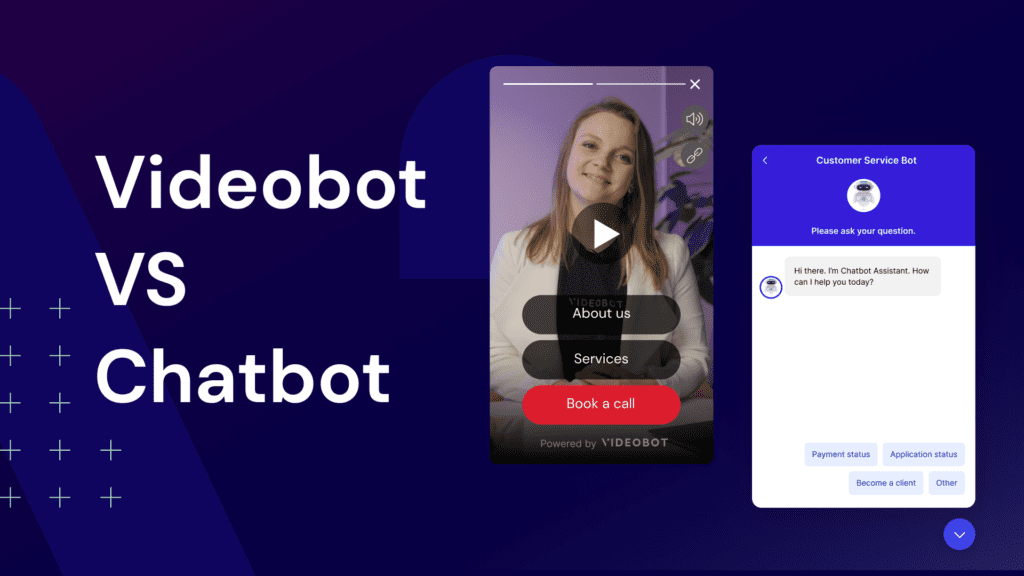6 Benefits of Doing Content Marketing with Interactive Video
Read More
Video Chatbots
Wondering what the main difference between a video bot and a chatbot are? This article covers everything you need to know
Book a Demo
Video bots are an emerging alternative to chatbots, following the global trend of video being preferred over text content. For example, 72% of consumers prefer video to text for receiving branded marketing information. Expanding website interactions from simple text to video comes with exciting new opportunities and considerations.
In this article, we review the key differences between both formats and uncover when each is most effectively utilized.
Video bots or video chatbots are a new form of user interaction technology. They add visual and auditory elements to the website experience. This enhances engagement and comprehension, adding a personal touch to the brand.
A simple use example is using video bots in your FAQ section. A pre-recorded video appears when the user finds and selects a question they want answers to. The short video answers the question using visual and auditory aids. This creates a more engaging and memorable experience compared to simple text.
Videobots can also be used in:
The functionality of video bots is supported by advanced technologies. These include cookie-less driven analytics and seamless integration with CRM systems. These capabilities enhance the overall performance of video bots, making them a valuable tool for businesses to connect with customers in a more personalized and efficient manner.
Chatbots are software designed to simulate human-like conversation users, especially over the internet. The user interacts with chatbots through text messaging through a dedicated virtual interface, usually a chat window.
These programs are often powered by artificial intelligence (AI) and are capable of understanding and generating human-like responses in natural language.
There are two main types of chatbots:
Chatbots can be simple and task-oriented, providing specific information or performing predefined tasks, or they can be more advanced, engaging in open-ended conversations and understanding user intent through context.
They are employed in a variety of industries to enhance user experience, streamline processes, and provide 24/7 support.
Regarding user experience, there are substantial differences between videobots and chatbots.
The implementation of chatbots and video bots has some key differences:
An important aspect of any website content is that it gets visibility online. Google, the biggest search engine often gives SEO advantages to video material, as video content is 50 times more likely to get organic page ranks in Google than plain text results.
However, it is worth noting that chatbot materials usually are not directly visible in search results.
Analyzing the specific needs and goals for communicating with customers is very important for a business.
If the primary objective is to address routine inquiries efficiently and cost-effectively, chatbots are an ideal solution. They are good for managing high call volumes and providing quick responses. AI-based chatbots are also better in situations that require a broad range of responses, as they can tailor their responses according to user demands and knowledge bases.
On the other hand, if the business focuses on delivering a more personalized and interactive customer service experience, especially in scenarios where visual communication is crucial, video bots are more effective. They are great for demonstrating product features, providing technical assistance, and offering live video customer support, as well as improving website navigation and user experience.
In conclusion, the choice between chatbots and video bots is not one-size-fits-all but rather depends on the specific needs and strategic goals of a business.
While chatbots excel in efficiency and handling high volumes of routine inquiries, video bots bring a new dimension to customer interaction with their ability to create a more personal and engaging user experience.
Whether it’s through the efficiency and scalability of chatbots or the engaging, personable nature of video bots, businesses have incredible tools at their disposal to enhance customer experience and foster stronger connections with their audience.
Video bot is a type of chatbot that uses videos as the main form of communication, while chatbot uses text-based communication. For example, Video bots can provide product demonstrations through video, while chatbot can answer questions through text.
Video bot communicates through video messages, while Chatbot communicates through text-based messages. For example, Video bots can provide visual instructions or product demonstrations, while Chatbots provides instant text responses to customer inquiries.
Video bots enhance user experience by providing visual demonstrations and tutorials, increasing engagement and understanding. It also allows for real-time feedback and interactive conversations through video, making the experience more dynamic and efficient.
The key features that distinguish Video bot from Chatbot are its ability to use video content for communication and interaction, while chatbots primarily use text-based messaging. Video bots can deliver personalized video messages, product demonstrations, and virtual tours, providing a more engaging and immersive user experience.
Video bot utilizes video content to demonstrate processes or provide visual instructions, while Chatbot relies on text-based communication to provide information or answer questions. For example, Video bot can show a step-by-step tutorial on assembling a product, while Chatbot can provide written instructions.

Don't waste time chasing mystery leads that end up being dead-ends. Videobots help potential clients understand your product and provide your team with amazing insights.